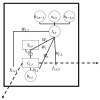Predicting and Interpreting Spatial Accidents through MDLSTM
- PMID: 33546503
- PMCID: PMC7913614
- DOI: 10.3390/ijerph18041430
Predicting and Interpreting Spatial Accidents through MDLSTM
Abstract
Predicting and interpreting the spatial location and causes of traffic accidents is one of the current hot topics in traffic safety. This research purposed a multi-dimensional long-short term memory neural network model (MDLSTM) to fit the non-linear relationships between traffic accident characteristics and land use properties, which are further interpreted to form local and general rules. More variables are taken into account as the input land use properties and the output traffic accident characteristics. Five types of traffic accident characteristics are simultaneously predicted with higher accuracy, and three levels of interpretation, including the hidden factor-traffic potential, the potential-determine factors, which varies between grid cells, and the general rules across the whole study area are analyzed. Based on the model, some interesting insights were revealed including the division line in the potential traffic accidents in Shenyang (China). It is also purposed that the relationship between land use and accidents differ from previous researches in the neighboring and regional aspects. Neighboring grids have strong spatial connections so that the relationship of accidents in a continuous area is relatively similar. In a larger region, the spatial location is found to have a great influence on the traffic accident and has a strong directionality.
Keywords: MDLSTM; interpretation; spatial; traffic accident.
Conflict of interest statement
The authors declare no conflict of interest.
Figures













Similar articles
-
Factors influencing traffic accident frequencies on urban roads: A spatial panel time-fixed effects error model.PLoS One. 2019 Apr 4;14(4):e0214539. doi: 10.1371/journal.pone.0214539. eCollection 2019. PLoS One. 2019. PMID: 30947277 Free PMC article.
-
Spatial analysis of traffic accidents near and between road intersections in a directed linear network.Accid Anal Prev. 2019 Nov;132:105252. doi: 10.1016/j.aap.2019.07.028. Epub 2019 Aug 19. Accid Anal Prev. 2019. PMID: 31437743
-
Traffic Accident Data Generation Based on Improved Generative Adversarial Networks.Sensors (Basel). 2021 Aug 27;21(17):5767. doi: 10.3390/s21175767. Sensors (Basel). 2021. PMID: 34502657 Free PMC article.
-
[A spatially explicit analysis of traffic accidents involving pedestrians and cyclists in Berlin].Bundesgesundheitsblatt Gesundheitsforschung Gesundheitsschutz. 2017 Dec;60(12):1328-1335. doi: 10.1007/s00103-017-2639-1. Bundesgesundheitsblatt Gesundheitsforschung Gesundheitsschutz. 2017. PMID: 29063156 Review. German.
-
Current Understanding of the Effects of Congestion on Traffic Accidents.Int J Environ Res Public Health. 2019 Sep 13;16(18):3400. doi: 10.3390/ijerph16183400. Int J Environ Res Public Health. 2019. PMID: 31540246 Free PMC article. Review.
Cited by
-
GATR: A Road Network Traffic Violation Prediction Method Based on Graph Attention Network.Int J Environ Res Public Health. 2023 Feb 15;20(4):3432. doi: 10.3390/ijerph20043432. Int J Environ Res Public Health. 2023. PMID: 36834124 Free PMC article.
References
-
- Road Traffic Injuries. [(accessed on 29 December 2020)]; Available online: https://www.who.int/health-topics/road-safety#tab=tab_1.
Publication types
MeSH terms
LinkOut - more resources
Full Text Sources
Other Literature Sources

